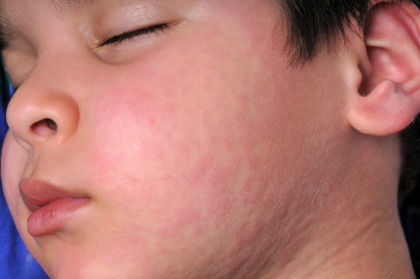Mumps

Mumps is a contagious viral infection that causes inflammation and swelling in the glands of the mouth that produce saliva.
KEYWORDS
for searching the Internet and other reference sources
MMR vaccination
Orchitis
Parotitis
Salivary glands
What Is Mumps?
Mumps is an infection caused by a virus. The mumps virus can infect various parts of the human body but typically attacks the salivary glands. The mouth has three pairs of salivary glands: one pair under the mouth and lower jaw; a second pair under the tongue; and a third pair in the back of both cheeks between the ear and the jaw. In most cases, mumps affects the third pair, called the parotid glands * , causing them to swell painfully.
In some patients, the virus spreads to the central nervous system * and causes a condition called aseptic meningitis * . Up to 15 percent of patients who have mumps, most commonly adults, will develop cases of meningitis with symptoms (such as headache and stiff neck).
Before the introduction of the mumps vaccine in 1967, the infection was also a major cause of acquired (not present at birth) deafness in childhood. Deafness occurs in about 1 out of 20,000 cases of mumps, often in only one ear.
Is Mumps Common?
Mumps was a common childhood illness in the United States until 1967, when a vaccine was made available to the public. Before the vaccine, most mumps infections occurred in children under the age of 15, and 5- to 9-year-olds were the most frequently affected age group. In the twenty-first century, many cases are diagnosed in young adults who have not been immunized.
Since 1967, cases of mumps have declined steadily. Statistics indicate the dramatic impact that the vaccine has had. In 1964, approximately 212,000 cases of mumps were diagnosed in the United States. By 2001, that number had dropped to 231 cases, according to the U.S. Centers for Disease Control and Prevention.
* parotid (puh-RAH-tid) gland is the salivary gland located in the jaw just beneath and in front of each ear.
* central nervous (SEN-trul NER-vus) system is the part of the nervous system that includes the brain and spinal cord.
* aseptic meningitis (a-SEP-tik meh-nin-JY-tis) is a milder, nonbacterial form of meningitis that is usually caused by a virus. Meningitis is an inflammation of the meninges, or the membranes that surround the brain and the spinal cord.
* epidemics (eh-pih-DEH-miks) are outbreaks of diseases, especially infectious diseases, in which the number of cases suddenly becomes far greater than usual. Usually, epidemics that involve worldwide outbreaks are called pandemics.
Epidemics * of mumps are rare and usually break out among people who have not been vaccinated and who live in close quarters, such as

How Do People Contract Mumps?
Mumps is highly contagious. People infected with the mumps virus can spread it when they laugh, cough, or sneeze. Direct contact with saliva or fluid from an infected person's nose also can spread mumps. Patients are contagious from about 1 day before their glands become swollen to up to 3 days after the swelling has improved.
What Happens When People Have Mumps?
Signs and symptoms
About 1 in 5 people who develop mumps have no symptoms. Many patients who do show signs of infection have only general symptoms such as a low fever, extreme tiredness, loss of appetite, muscle pain, and headache. Symptoms usually appear within 14 to 25 days after exposure to the virus.
Only 30 to 40 percent of people who become infected with the mumps virus have the swelling in the jaw area that most people associate with mumps. Earache and tenderness in the jaw are often the first signs of inflamed parotid glands. In 2 out of 3 cases of mumps, both parotid glands become swollen and painful, with one side swelling a few days before the other. Some patients also experience swelling in the other salivary glands. Talking, chewing, and swallowing can be painful, especially if the person eats or drinks acidic or sour food and beverages (such as lemonade and orange juice), which make the salivary glands squeeze out more saliva and increase discomfort.
Diagnosis and treatment
A doctor typically diagnoses mumps by examining a person who has symptoms of the infection. Other infections can cause swelling in the salivary glands, too, so a doctor may take a sample of blood to look for antibodies * to the virus. Other tests that can be used to diagnose mumps include culturing * samples of saliva or urine to find the mumps virus.
Most cases of mumps can be treated at home. Over-the-counter pain medication, such as acetaminophen (uh-see-teh-MIH-noh-fen), can ease pain and fever, and warm or cold packs can soothe the pain of swollen, inflamed parotid glands. Resting and drinking plenty of non-acidic fluids help the body recover. The symptoms of mumps begin to clear up after 1 week and are usually gone within 10 days.
* antibodies (AN-tih-bah-deez) are protein molecules produced by the body's immune system to help fight specific infections caused by microorganisms, such as bacteria and viruses.
* culturing (KUL-chur-ing) means being subjected to a test in which a sample of fluid or tissue from the body is placed in a dish containing material that supports the growth of certain organisms. Typically, within days the organisms will grow and can be identified.
Complications
Complications of mumps are rare but can be serious and may require additional treatment under a doctor's care or even hospitalization. The infection can lead to inflammation and swelling of the brain (encephalitis, en-seh-fuh-LYE-tis), as well as inflammation of the pancreas * (pancreatitis, pan-kree-uh-TIE-tis), other organs, or the membranes covering the brain and the spinal cord (meningitis). If symptoms of encephalitis or meningitis occur, it usually is within 3 to 7 days after the swelling of the parotid glands begins. These symptoms include high fever, stiff neck, and headache. In some patients with mumps, an electrocardiogram * (EKG) will show signs of myocarditis * , but the condition rarely is severe enough to produce symptoms with mumps.
Up to half of all males who become infected with the mumps virus after puberty experience painful swelling of the testicles * as a complication of the disease. Usually one testicle becomes swollen, but in some cases both do. High fever, chills, headache, nausea (NAW-zee-uh), and vomiting accompany the swelling, which generally goes away within a week after it appears, along with the fever and other symptoms. In rare cases, this swelling can permanently damage the testicle leading to infertility * because of reduced ability to produce sperm cells. Only 5 percent of females who contract mumps after puberty will develop inflammation of the ovaries * , which causes abdominal * pain and other symptoms similar to those of appendicitis * .
Can Mumps Be Prevented?
Immunization is the best way to prevent mumps, and the vaccine usually is administered during early childhood. The vaccine requires two doses and generally is given in the same shot with the vaccines for measles and rubella. It is known as the MMR (measles-mumps-rubella) vaccine. The first dose typically is given when an infant is between 12 and 15 months old and the second when the child is between 4 and 5 years old. Avoiding close contact with someone who has been diagnosed with mumps also reduces the risk of contracting the virus, particularly if the uninfected person has not been vaccinated.
* pancreas (PAN-kree-us) is a gland located behind the stomach that produces hormones and enzymes necessary for metabolism and digestion.
* electrocardiogram (e-lek-tro-KAR-dee-o-gram), also known as an EKG, is a test that records and displays the electrical activity of the heart.
* myocarditis (my-oh-kar-DYE-tis) is an inflammation of the muscular walls of the heart,
* testicles (TES-tih-kulz) are the paired male reproductive glands that produce sperm.
* infertility (in-fer-TIH-lih-tee) is the inability of females to become pregnant or of males to cause pregnancy.
* ovaries (O-vuh-reez) are the sexual glands from which ova, or eggs, are released in women.
* abdominal (ab-DAH-mih-nul) refers to the area of the body below the ribs and above the hips that contains the stomach, intestines, and other organs,
* appendicitis (ah-pen-dih-SY-tis) is an inflammation of the appendix, the narrow, finger-shaped organ that branches off the part of the large intestine in the lower right side of the abdomen.
Resources
Organizations
U.S. Centers for Disease Control and Prevention (CDC), 1600 Clifton
Road, Atlanta, GA 30333. The CDC posts information about mumps at its
website.
Telephone 800-311-3435
http://www.cdc.gov
U.S. National Library of Medicine, 8600 Rockville Pike, Bethesda, MD
20894. The National Library of Medicine has a website packed with
information on diseases such as mumps, consumer resources, dictionaries
and encyclopedias of medical terms, and directories of doctors and
helpful organizations.
Telephone 888-346-3656
http:llwww.nlm.nih.gov
World Health Organization (WHO), Avenue Appia 20, 1211 Geneva 27,
Switzerland. WHO provides information about mumps at its website.
Telephone 011-41-22-791-2111
http://www.who.int
Website
KidsHealth.org
. KidsHealth is a website created by the medical experts of the Nemours
Foundation and is devoted to issues of children's health. It
contains articles on a variety of health topics, including mumps.
http://www.KidsHealth.org
Comment about this article, ask questions, or add new information about this topic: